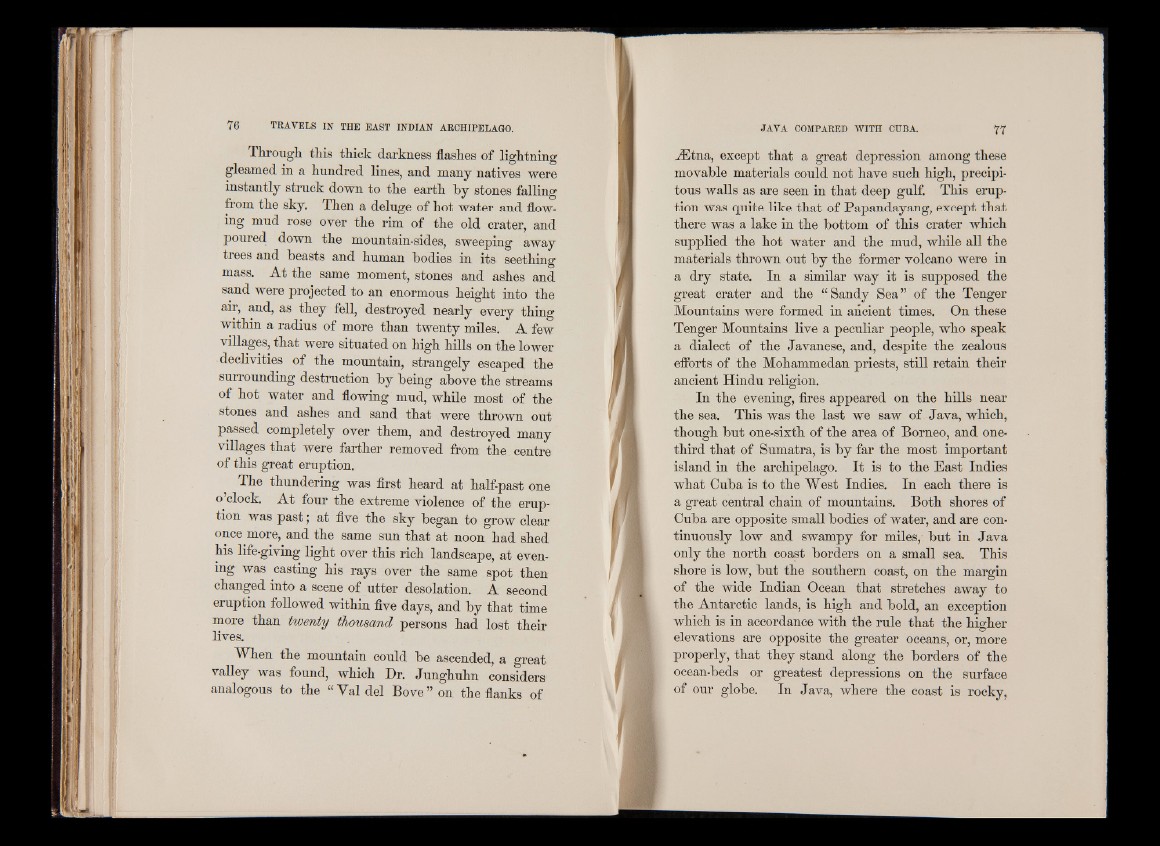
Through this thick darkness flashes of lightning
gleamed in a hundred lines, and many natives were
instantly struck down to the earth Tby stones falling
from the sky. Then a deluge of hot water and flowing
mud rose over the rim of the old crater, and
poured down the mountain-sides, sweeping away
trees and "beasts and human "bodies in its seething
mass. At the same moment, stones and ashes and
sand were projected to an enormous height into the
air, and, as they fell, destroyed nearly every thing
within a radius of more than twenty miles. A few
villages, that were situated on high hills on the lower
declivities of the mountain, strangely escaped the
surrounding destruction by being above the streams
of hot water and flowing mud, while most of the
stones and ashes and sand that were thrown out
passed completely over them, and destroyed many
villages that were farther removed from the centre
of this great eruption.
The thundering was first heard at half-past one
o’clock. At four the extreme violence of the eruption
was past j at five the sky began to grow clear
once more, and the same sun that at noon had shed
his life-giving light over this rich landscape, at evening
was casting his rays over the same spot then
changed into a scene of utter desolation. A second
eruption followed within five days, and by that time
more than twenty thousand persons had lost their
lives.
When the mountain could be ascended, a great
valley was found, which Dr. Junghuhn considers
analogous to the “ Val del Bove” on the flanks of
ACtna, except that a great depression among these
movable materials could not have such high, precipitous
walls as are seen in that deep gulf. This eruption
was quite like that of Papandayang, except that
there was a lake in the bottom of this crater which
supplied the hot water and the mud, while all the
materials thrown out by the former volcano were in
a dry state. In a similar way it is supposed the
great crater and the “ Sandy Sea” of the Tenger
Mountains were formed in ancient times. On these
Tenger Mountains live a peculiar people, who speak
a dialect of the Javanese, and, despite the zealous
efforts of the Mohammedan priests, still retain their
ancient Hindu religion.
In the evening, fires appeared on the hills near
the sea. This was the last we saw of Java, which,
though but one-sixth of the area of Borneo, and one-
third that of Sumatra, is by far the most important
island in the archipelago. It is to the East Indies
what Cuba is to the West Indies. In each there is
a great central chain of mountains. Both shores of
Cuba are opposite small bodies of water, and are continuously
low and swampy for miles, but in Java
only the north coast borders on a small sea. This
shore is low, but the southern coast, on the margin
of the wide Indian Ocean that stretches away to
the Antarctic lands, is high and bold, an exception
which is in accordance with the rule that the higher
elevations are opposite the greater oceans, or, more
properly, that they stand along the borders of the
ocean-beds or greatest depressions on the surface
of our globe. In Java, where the coast is rocky,